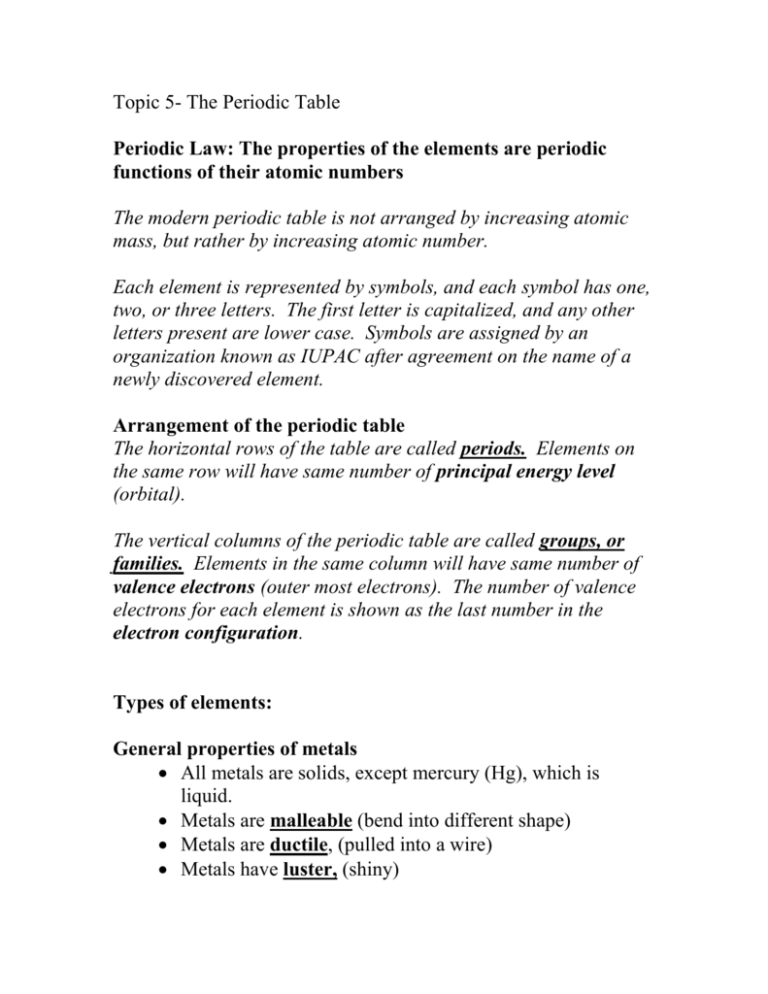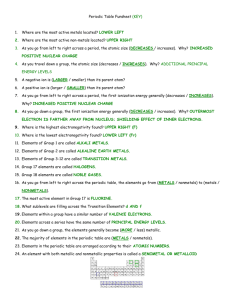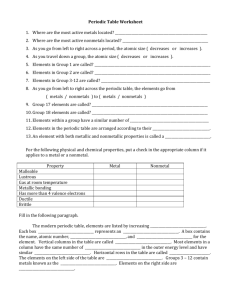Topic 5- The Periodic Table
advertisement

Topic 5- The Periodic Table Periodic Law: The properties of the elements are periodic functions of their atomic numbers The modern periodic table is not arranged by increasing atomic mass, but rather by increasing atomic number. Each element is represented by symbols, and each symbol has one, two, or three letters. The first letter is capitalized, and any other letters present are lower case. Symbols are assigned by an organization known as IUPAC after agreement on the name of a newly discovered element. Arrangement of the periodic table The horizontal rows of the table are called periods. Elements on the same row will have same number of principal energy level (orbital). The vertical columns of the periodic table are called groups, or families. Elements in the same column will have same number of valence electrons (outer most electrons). The number of valence electrons for each element is shown as the last number in the electron configuration. Types of elements: General properties of metals All metals are solids, except mercury (Hg), which is liquid. Metals are malleable (bend into different shape) Metals are ductile, (pulled into a wire) Metals have luster, (shiny) Metals are good conductors of heat and electricity Metals have low ionization energy, and low electronegativity values Metals tend to lose electrons to form positive ions with smaller radii General properties of nonmetals Nonmetals are not malleable or ductile, they tend to be brittle in the solid phase Nonmetals have high ionization energy and high electronegativity values Nonmetals are poor conductors of heat and electricity Nonmetals tend to gain electrons to become negative ions with radii larger than their atoms Transition elements: Elements of group 3 through 12 Transition elements have multiple oxidation states Release Color when reacted in solution Noble Gases: Group 18 elements Unreactive, inactive, inert Octet Rule - Have 8 electrons on the outer most energy level, (valence electrons) (orbital) Alkali metals Group 1 elements Most reactive metals Like to lose 1 electron and becomes +1 ion Francium (Fr) is the most reactive metal Alkaline earth metals Group 2 elements Second most Reactive metals Like to lose 2 electrons and becomes +2 ion Halogens Group 17 elements Most reactive nonmetals Like to gain 1 electron and becomes -1 ion, called halides Fluorine (F) is the most reactive nonmetal Metals: Left side of the steps Nonmetal: Right side of the steps Metalloid: B, Si, Ge, As, Sb, and Te Gas molecules: H, N, O, F, Cl, He, Ne, Ar, Kr, Xe, and Rn Liquid elements: Hg (metal) and Br (nonmetal) Properties of elements: As you move from left to right of each period (row) 1. Ionization energy increases 2. Electronegativity increases 3. Atomic radii decreases As you move from top to bottom of each group (column) 1. Ionization energy decreases 2. Electronegativity decreases 3. Atomic radii increases






